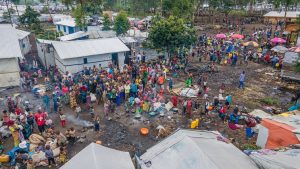As the COVID-19 death toll edges closer to 41 000 in the United States with 765 000 cases, small protests have sprung up in several states against stringent lockdown or stay-at home measures.
Despite issuing new guidance on measures to reopen economies in a systematic step-by-step basis, President Donald Trump has cheered on protests against social distancing measures in some states run by Democratic Governors.
Thousands of protestors took to state capitols across the country, buoyed on by President Trump tweeting his support for what he termed the liberation of certain states, in violation of his own federal guidelines limiting gatherings and urging social distancing.
” I think we do have a sobering guidance. But I think some things are too tough. No, these are people expressing their views. I see where they are and I see the way they’re working. And they seem to be very responsible people to me. But it’s, you know, they’ve been treated a little bit rough.”
At least 20 states have now seen rallies against what many protestors are calling government over-reach amidst tough economic conditions with more than 22 million jobless claims in the country over the last month. These were some of the views of protestors in Washington State’s Capitol of Olympia on Sunday.
” I really feel that our governor is overstepping his authority on this shutdown proclamation, and he’s really hurting our economy and I really think it’s unfortunate that a lot of our businesses in the state are unable to operate,” says one of the protestors in Olympia.
Another protestor says; ” I’m concerned, but it’s been politicised. This is a tool now, this is a tool to keep us at home and on house arrest. We’re not on house arrest. We’ve been asked to social distance, we can wear our masks, we can stay distance from people. I’m not on house arrest, I refuse. I walk out of my house now.”
Others are now making healthier decisions.
“Our best defense is a healthy immune system and I take care of my body. I eat the right food I take vitamins, I drink the right water, vitamin D, vitamin C, it’s been proven already. So we have everything that we need – we don’t need a vaccine. You know.. my body, my choice. I take care of myself , I should be able to have the freedoms to go out and do my work, my business, my job, take care of my family.”
While that plays out, States are gearing up to increase testing and tracing capacity in lieu of any reopening of economies, particularly in the hardest hit parts of the country like New York. But as Governor Andrew Cuomo explained, this cannot be done without the financial and logistical backing of the Federal Government.
“Tracing requires an army, literally an army. You would need thousands of people who just trace in the state of New York, right? Because any one person then leads to 10, 20 possible people who were infected. And you have to trace all through those people. You find the positive person, you isolate them. The trick with testing is not that we don’t know how to do it. We’ve done it better in this state than almost any other state, almost any of the country. It’s bringing this up to scale.”
In the video below, SABC’s Sherwin Bryce-Peas reports on America’s efforts to flatten the curve:
After much criticism over a lack of testing capacity, President Trump announced that he would use the Defense Production Act to compel the private sector to produce 20 million coronavirus testing swabs per month.
“You must remember that the governors wanted to have total control over the opening of their states, but now they want to have us, the federal government, do the testing. And again, testing is local, you can’t have it both ways. Testing is a local thing and it’s very important. It’s great, but it’s a local thing.”
According to available data, there are 150 000 diagnostic tests conducted each day but Harvard University researchers estimate that to ease restrictions the country would need to at least triple that pace of testing.






